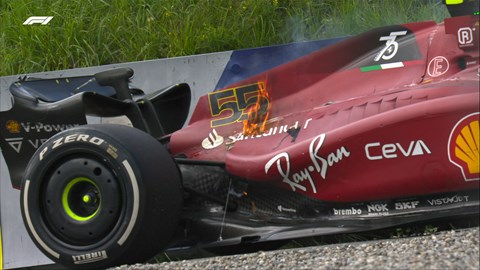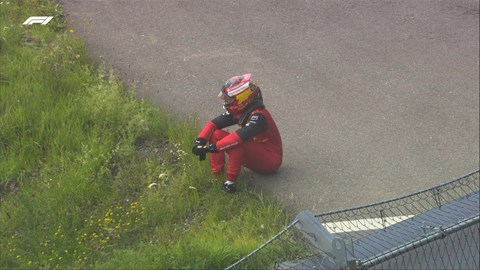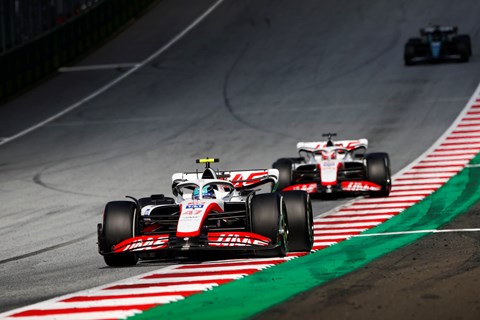► Leclerc wins
► Verstappen second – but wins sprint race
► Mercedes place 3rd and 4th
Despite lukewarm support for audiences and tepid races, F1 continues to persist with sprint weekends – and Austria saw one of the most processional yet. The sprint race itself was largely routine, with Verstappen winning and Leclerc and Sainz rounding off the podium. And it was also a chance for out of place faster cars to return to their more natural starting positions – see Perez.
The race on Sunday proved to be far more eventful, and once again had all the hallmarks of a typical race in 2022. Leclerc won – despite his car’s reliability – Max was upset on the radio, and a Ferrari blew up. Elsewhere, Mercedes somehow came 3rd and 4th despite having a car three to four tenths off the pace.
Keep reading for our full report on Sunday’s race

1. Ferrari politics
Everyone in the paddock knows that Leclerc represents the best chance for a Ferrari championship this year – apart from the Maranello team itself. At Silverstone last week questionable strategy calls saw Sainz win with Leclerc dropping to fourth, and the Scuderia pitwall looked equally dysfunctional in Saturday’s sprint race.
Rather than saving tyres and attacking Verstappen, the Ferrari drivers managed to squabble throughout the race, gifting the Red Bull driver a healthy lead. It’s incredible to think that Ferrari – the same team that forced Barrichello and Massa to move over multiple times – won’t implement team orders when it’s obvious they need to. It’s more alarming when you consider Red Bull, their main title rivals, have no qualms compromising Perez for the benefit of Max.
“The fastest car on track is the one that is prioritised,’ said team principal Mattia Binotto, after the race. ‘If later in the championship there will be one of the two drivers who got most of the opportunities, certainly we will try to gain full priority, but it’s not the situation right now. So we need to cope with it.’
‘Still, I’m happy to see those two drivers fighting. When there are team orders, everybody is blaming us because we could have free fight, and we go the free fight, we should have team orders.’
Whether or not this ‘let them race at the moment’ ethos comes back to bite Ferrari later in the year remains to be seen. Spoiler: it will.

2. Ferrari reliability
Superior tyre degradation and good pace meant Ferrari was on course for a 1-2 with less than half the race left to go. However, Maranello’s reliability issues resurfaced in spectacular fashion.
While attempting to overtake Verstappen, Sainz’s Ferrari lost power before showering sparks and then seemingly tearing itself apart. ‘As soon as it happened really, there was nothing coming from the engine that this was about to happen,’ the Spaniard recounted to Sky.
‘It was very sudden and I’m a bit lost for words because it is a big loss on points and it would have been a huge result for the team. I think it would have been an easy 1-2,’ he added.
So violent was the failure, that the F1-75’s bodywork was visibly cracked by an internal explosion. It’s unlikely engineers will be able to retrieve much, so Sainz will probably have engine penalties later in the year.
At the same time, Leclerc also had to battle with a sticky throttle pedal in the last 15 laps or so of the race, with his problems starting at around the same as his teammate’s engine failure.
3. A turning point for Ferrari
In many ways, Sainz’s DNF is probably the best thing to happen for the Ferrari team overall. It surely marks the end of the Spaniard’s title push. That means the team can now properly prioritise Leclerc – something they’ve struggled with throughout the year.
4. Mercedes does damage limitation
After the successful debut of a heavily upgraded floor at Silverstone, Mercedes appeared to be very strong in Austria too – something Brackley’s engineers didn’t expect at this track. However, both drivers rewarded the team by firing their Silver Arrows into the scenery on Friday qualifying, with both crashes taking place minutes apart.
The accidents were high speed and relatively similar, with the back end of the car unable to live with the demands being thrown at it. It means Hamilton started 9th in the sprint race and Russell 4th, but it ultimately resulted in a 3rd and 4th place on Sunday regardless. The car may not be the quickest, but Mercedes’ reliability and consistency is relentless.
As for those crashes? In some ways it’s a sign the car has finally turned a corner: Before this weekend neither Mercedes driver had crashed in the dry – and that’s probably because of how little confidence the car gave. Now, both drivers must feel they have the beginnings of a car they can lean on, and they’re beginning to take risks with it.
The W13’s bouncing and porpoising issues appear to be solved and moving forward Mercedes will work on bringing small but significant upgrades to every race for the rest of this year. A win could still be on the cards.
5. Flexifloor gets delayed
Flexible floors allow cars to run lower and therefore generate more underfloor downforce, without their underfloor planks being worn down too much. The result? A car with more efficient downforce that can be quicker in a straight-line but still on rails in the corners – see the Red Bull. The only issue? It’s very much against the spirit of the rules – even though it passes the regulations as they are currently written. Think VW’s emissions test defeat device, and you’re pretty much there.
With that in mind, the FIA said it’ll introduce a new ‘patch’ of rules to stamp the practice out, with cars to be tested at the French GP. However, successful lobbying has now moved that date to the Belgium GP, just after the summer break.
Ferrari have confirmed they’ll need to make alterations to their floor design to pass the new rules, and it’s likely the Red Bull will too. As for Mercedes? The team says it hadn’t thought to exploit the idea of a flexible floor in the first place, so it won’t need to make any changes. With that in mind, we could have an interesting second-half to the season, and we could also see the likes of Red Bull and Ferrari battling the problems Mercedes faced in the first half of the season.
6. Track limits
Track limits proved to be a huge talking point throughout the weekend, directly affecting both the F1, F2 and F3 races at the Red Bull Ring. Most drivers were given warnings throughout the weekend with 43 in total. Several got penalties – and the rules were of particular issue for Perez. The Mexican driver was only informed about a deleted lap after he was already in Q3 – meaning he had to start the sprint race from 13th place.
There seemed to be a lot of infractions, but at least the rules appeared to be binary and consistent, with no room for the stewards to interpret anything.

7. Mick Schumacher begins to impress
Mick Schumacher has had a troubled year at Haas, but he’s showing serious signs of improvement. A strong weekend in Silverstone – in which he got his first points – was followed up with 7th in qualifying, 9th in the sprint and then a hugely impressive 6th in the race – even beating his more experienced teammate; Kevin Magnussen.
Of particular note was the impressive defense he put up against Lewis Hamilton in the sprint race, carefully positioning his car and using DRS to keep the seven-time-world champion behind. It’s taken a while, but Mick is now showing the skill he did in his championship-winning F2 year.